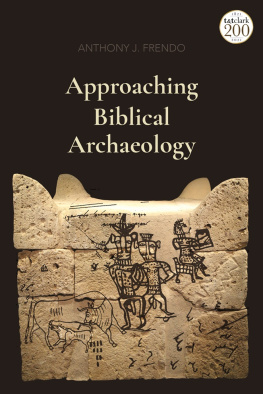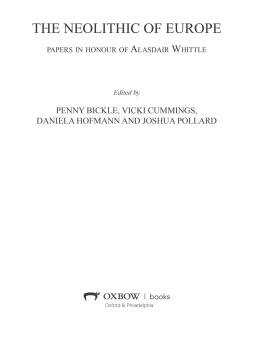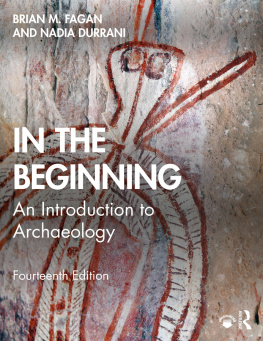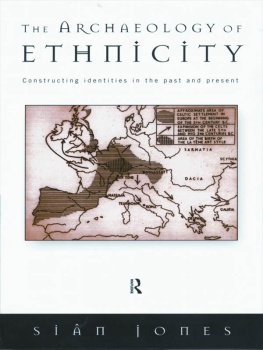ARCHAEOLOGICAL SEDIMENTS AND SOILS
ARCHAEOLOGICAL SEDIMENTS AND SOILS
Analysis, Interpretation and Management
edited by Anthony J. Barham
Richard I. Macphail
University College London Institute of Archaeology Publications, Vol. 4
Originally published by University College London Institute of Archaeology
First published 2009 by Left Coast Press, Inc.
Published 2016 by Routledge
2 Park Square, Milton Park, Abingdon, Oxon OX14 4RN
711 Third Avenue, New York, NY 10017, USA
Routledge is an imprint of the Taylor & Francis Group, an informa business
Copyright 1995 The Institute of Archaeology
All rights reserved. No part of this book may be reprinted or reproduced or utilised in any form or by any electronic, mechanical, or other means, now known or hereafter invented, including photocopying and recording, or in any information storage or retrieval system, without permission in writing from the publishers.
Notice:
Product or corporate names may be trademarks or registered trademarks, and are used only for identification and explanation without intent to infringe.
Library of Congress Cataloguing-in-Publication Data available from the publisher
ISBN 978-0-905853-31-4 paperback
Contents
Richard Macphail and Paul Goldberg
Anne Gebhardt
Wendy Matthews
Timothy A. Quine
David D. Gilbertson
Anthony J. Barham
Matthew Canti
Jon G. Hather and Joanna C. Ellison
Mark G. Macklin
David R. Bridgland
Anthony J. Barham | Department of Human Environment, Institute of Archaeology, University College London, London WC1H OPY, UK |
David R. Bridgland | Department of Geography, University of Durham, South Road, Durham, DH1 3LE, UK |
Matthew Canti | Ancient Monuments Laboratory, English Heritage, 23 Savile Row, London W1X 2AB, UK |
Joanna C. Ellison | Australian Institute of Marine Sciences, Townsville, Queensland, Australia |
Anne Gebhardt | 5, Villa Cadran Solaire, 92120 Montrouge, France |
David D. Gilbertson | Institute of Earth Studies, University of Wales, Aberystwyth, Llandinam Building, Aberystwyth, Dyfed SY23 3DB UK |
Paul Goldberg | Department of Archaeology, Boston University, 675 Commonwealth Avenue, Boston MA 02215 USA |
Jon G. Hather | Department of Human Environment, Institute of Archaeology, University College London, London WC1H OPY UK |
Mark G. Macklin | School of Geography, University of Leeds, Woodhouse Lane, Leeds LS2 9JT UK |
Richard I. Macphail | Department of Human Environment, Institute of Archaeology, University College, London WC1H OPY UK |
Wendy Matthews | The McDonald Institute for Archaeological Research, University of Cambridge CB2 3JW UK |
Timothy Quine | Department of Geography, University of Exeter, Amory Building, Rennes Drive, Exeter EX4 4RJ UK |
A key aim of the Tenth Anniversary Conference of the Association for Environmental Archaeology was to focus discussion on the linkages and trajectories of Environmental Archaeological research in relation to trends in related and cognate disciplines. The session on Archaeological Sediments and Soils reflected this goal. It explored the aims, objectives and limitations encountered when methodologies and techniques linked to Earth Science are applied across a wide range of scales to the particular problems of stratigraphic and sediment context analysis and interpretation presented by research on archaeological sites and past landscapes.
In part, this third and final volume of Conference Proceedings reflects a long and distinguished tradition of investigation focused on the geology, sedimentology and pedology of archaeological sites. This tradition, exemplified by Professor F.E. Zeuner and Dr Cornwall when working at the Institute of Archaeology during the 1950s, made both the venue for the Conference and the post-conference excursion to the internationally significant Quaternary and Palaeolithic site at Boxgrove, West Sussex apposite choices for reflexive and reflective discussion.
At Boxgrove, the stratigraphic sections introduced by the site Director, Mark Roberts (see Plate 1) and viewed by Conference participants reflected the complex interplay of sedimentary and pedogenic processes which characterise archaeological sites, particularly those of Pleistocene age. Deposits range from beds whose process origin is ultimately coupled to global climatic change, such as periglacial solifluction, marine transgression and regression and sediment diagenesis operating over timescales of 103 to 105 years down to subtle microstratigraphy produced by individual tides, local streamflow and bioturbation responsible for subtle modification of stratigraphy and assemblage taphonomy, produced over timescales of 101 to 102 years. The interplay of these processes and timescales in influencing the stratigraphy, chronology and taphonomy of artefacts and ecofacts amply demonstrated the complex research objectives commonly encountered in geoarchaeology. The analytical approaches focused and deployed at the site, and discussed during the field excursion, ranged from dating techniques such as TL, through biostratigraphy of marine foraminifera to sediment facies analysis and soil micromorphology. All are required in order to unravel the stratigraphic and chronological complexity of the site. Equally they reflected the added research challenges posed in the archaeological application of Earth Science. The temporal and spatial precision and resolution demanded for adequate archaeological interpretation, and the resultant sampling and technical precisions required, are frequently critical issues. In essence, however, all of the key problems, such as identification of depositional process and the separation of primary features from post-depositional transformations, to stratigraphy and the erection of reliable geochronology reflected the traditions inspired by Zeuner (1937, 1940, 1959) and Cornwall (1953, 1958). The key approaches to satisfactorily resolving the archaeological challenges posed by a site such as Boxgrove would also have been familiar to Zeunernamely a three-dimensional and highly detailed approach to stratigraphy coupled to meticulous archaeological recording and the application of dating techniques, precise taxonomic identification and uniformitarian use of sedimentary facies analogues in order to interpret and test multiple competing hypotheses.










